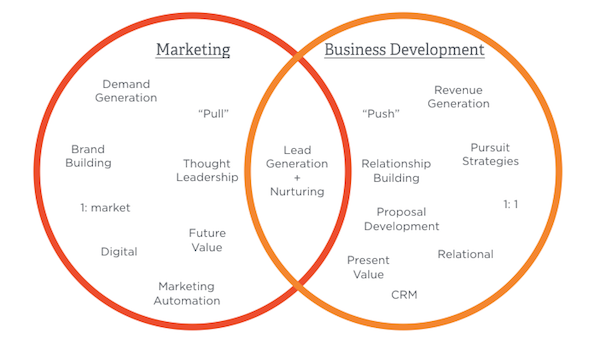This article outlines the push/pull relationship of marketing and business development in a professional services firm.
Something I’ve noticed over my 20+ years marketing professional services firms — while most firms are good at generating revenue, few are good at creating demand. Put another way, their well developed business development machine stands in stark contrast to their largely neglected marketing muscles.
By contrast, a sustainable firm is well balanced. It makes investments in marketing to generate demand for tomorrow. And, it invests in business development to create revenue for today. It uses marketing to open new markets and introduce new offerings to existing ones. And, it relies on business development to develop relationships and sell projects now. While business development is responsible for present value, marketing is responsible for future value. The two disciplines meet in the middle where leads are generated and nurtured:

Business Development Creates Revenue for Today
A lot of firms pride themselves on their business development prowess. Principals of the firm wear the title “doer/seller” as a badge of honor. They’re expected to go into the community, make connections, and turn those relationships into revenue. And, they’re exceptional at it.
They’ve built processes around it — pursuit strategies and capture plans; go/no go models and proposal support teams. They’re exceptional at operating in the here and now (depending on the nature of your firm, that might mean the next 3 months or the next 1-2 years).
They’re fabulous at relationship building. They know how to create rapport and make connections that yield revenue for this year and next year (I could name a few clients that could literally sell ice to an eskimo as the old saying goes). And, often these relationships yield revenue for the foreseeable future.
They’re great at partnering — building teams and joint ventures to pursue new business relationships with clients based on unique individual needs. They’re great at team chemistry. And, they know how to guide a client to a sale.
This consistent “push” of key account management activities is the lifeblood of the firm. Without a steady flow of revenue, virtually anything else a firm could do is dead on arrival.
Marketing Creates Demand for Tomorrow
A well balanced firm takes the wins of today and uses a portion of it to invest in demand for tomorrow. It brings the same rigor and discipline to marketing as it does to business development. Principals of the firm work diligently to pursue market-driven strategies. They target specific markets for investment and do the necessary research to identify systemic client problems they’re capable of solving. While these problems may be directly tied to an individual client experience they’re macro in nature. They represent where those leaders see the marketplace going not necessarily where clients are demonstrating interest today.
They’re cognizant of the role their brand plays in shaping the opportunities that will come to define the firm tomorrow. They apply strategies that will help the firm become “known” for those big topics and ideas over time. As a result, they invest in thought leadership as a means of expressing that expertise. They use thought leadership to articulate a compelling, relevant and unique point-of-view on the needs of potential clients in the marketplace (both today and tomorrow).
They’re forward-thinking in their technology investments and seek out new ideas and systems, like marketing automation, to make the process work better.
Those ongoing investments in brand building, thought leadership, digital marketing and technology create a “pull” in the marketplace that generates new leads for the firm both today and tomorrow while opening doors that were otherwise closed to the firm’s traditional business development activities.
These demand-oriented firms are comfortable and willing to elevate marketing leaders to a place at the table with practice leaders in shaping the future direction and vision of the firm. And, they recognize marketing as an unassailable resource to understand clients’ unmet needs, develop knowledge, and create demand.
Finding Balance in the Middle
A highly developed firm is well balanced. It relies on a strong culture of business development to create revenue for today. And, it invests a portion of that revenue to high-value marketing activities (like thought leadership and digital marketing) that will create demand for tomorrow. It recognizes that one without the other is destined to fail. A business development-driven firm often misses out on the market shifts that shape tomorrow’s marketplace. And, a marketing-heavy firm could run out of resources before realizing the outcomes of its investment.
A well balanced firm elevates original marketing thinkers to positions of leadership and prominence in the firm alongside the practice leaders responsible for revenue generation today. Both disciplines meet in the middle where leads are generated and nurtured to create both present and future value.

